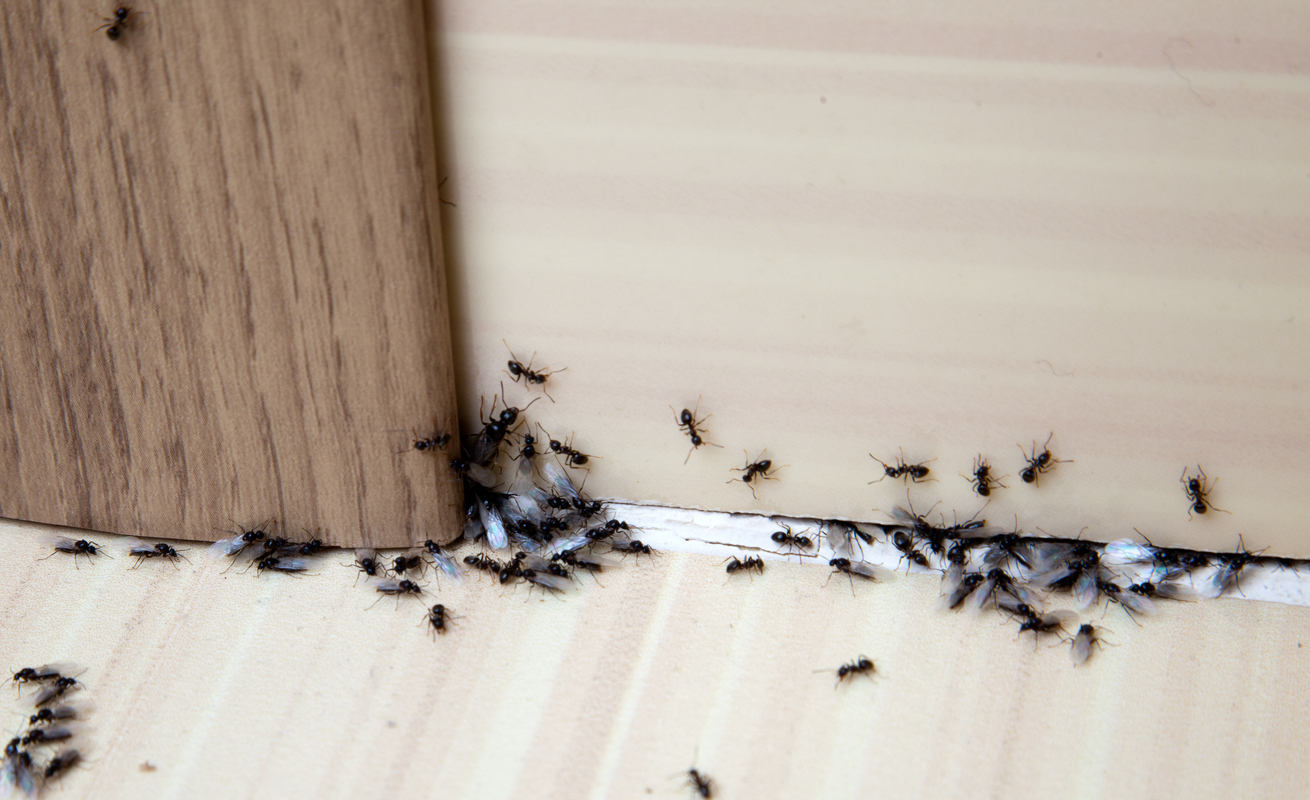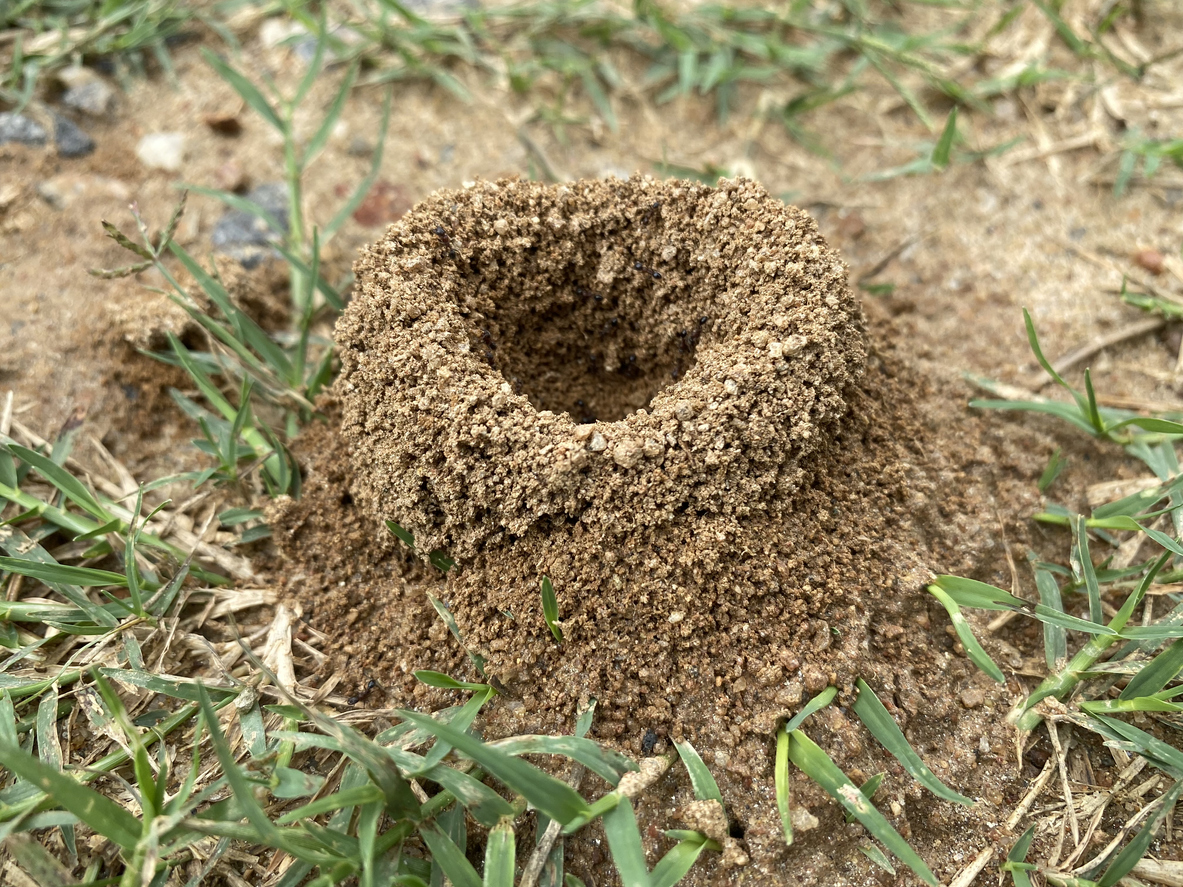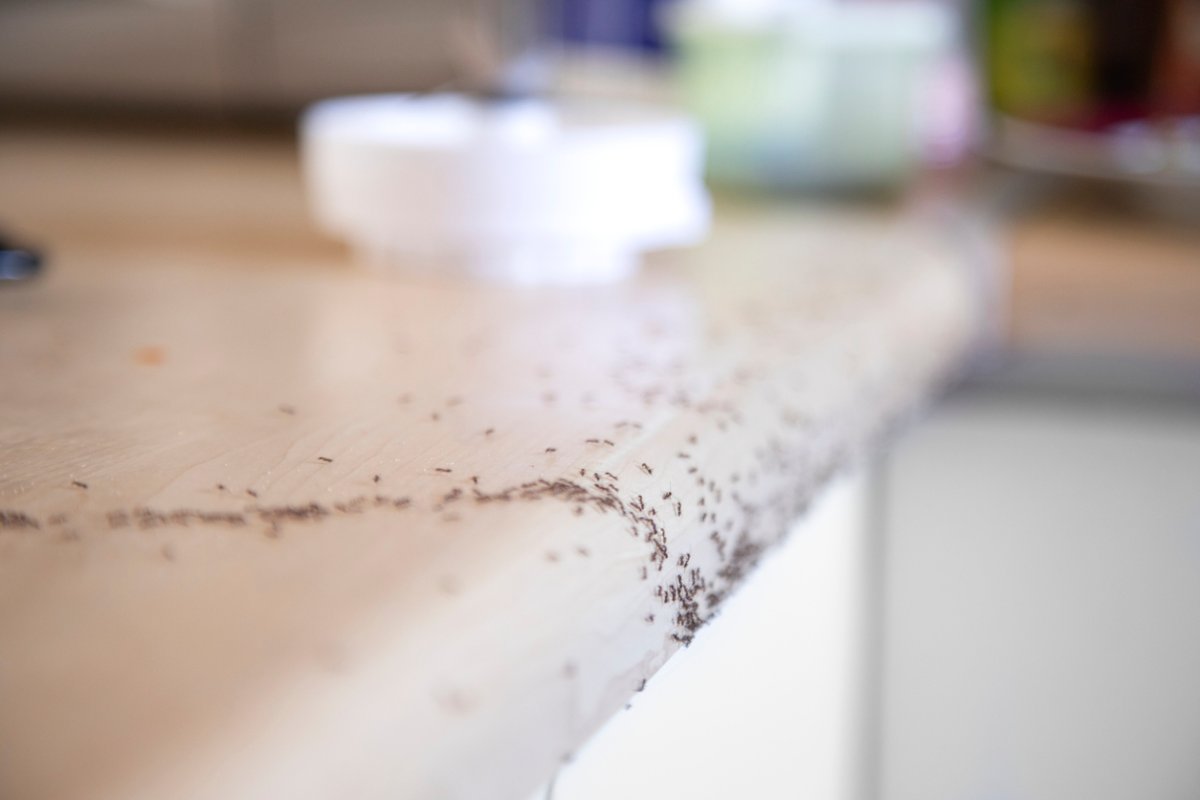We may earn revenue from the products available on this page and participate in affiliate programs. Learn More ›
Q: I squashed an ant on my kitchen countertop this morning only to spot more circling the sink. Where did all of these ants come from? How do I get rid of ants in the kitchen?
A: House ants, which are usually the Little black, Pharaoh, Argentine, or Odorous house varieties, enter kitchens through cracks in windows, doorways, or floors in search of morsels that might replenish their own colony’s food and water supply.
RELATED: Solved! This is How to Get Rid of Ants in the Kitchen Once and for All
Killing one ant in the kitchen isn’t the solution: Where there’s one ant, there’s usually a colony nearby, and each ant leaves behind a trail of chemicals called pheromones that attract its species in the vicinity. Until you wipe out the ant colony where the egg-laying queen resides, she’ll continue to reproduce and send additional worker ants into your home to score free refreshments on your kitchen countertops and inside sinks and cabinets.
Why do ants suddenly appear in my kitchen? Is it a seasonal thing, or are there certain foods they are attracted to?
There are several reasons why ants might suddenly show up in your cooking space. One of the most common causes for a sudden ant infestation is the presence of a food source. If ants find food in your home, they will alert the other ants in their colony by using pheromones as a chemical trail for the other ants to follow. This is why it might feel like the number of ants in your kitchen increased exponentially over just a day or so.
While ants will eat nearly anything, they prefer sweeter foods, such as honey, sugar, fruit juice, and syrup. So, if they’re finding these types of foods in your home, they may be even more likely to stick around. An ant colony also relies on water for survival, so if the ants find a reliable water source in your kitchen, they may be more likely to stay and increase in number. In addition to spills on the floors, ants can find water in moist and humid areas of the home, such as near doors and windows, around the refrigerator, or under a sink.
You’re less likely to see ants in the winter because they are mostly dormant and hibernating during the colder months. A sudden appearance once the weather warms signals that the ants are coming out of hibernation and may be reappearing in your home. The weather outside can also drive ant infestations. They prefer damp environments, so when it becomes hot and dry in the summer, ants might begin entering homes to find more favorable conditions.
You may also notice more ants in your kitchen after heavy rains. If the rains flood their nest, they’ll be looking for somewhere dry to live.

To clear an ant infestation, first determine the ants’ entry point into the kitchen.
Observe those ants in the kitchen for a few minutes to find out where they’re coming from—be it cracks in the kitchen floor, crumbled caulk along a windowsill, a torn window screen, or small holes inside of a kitchen cabinet mounted against an exterior wall. You’ll target the entry point in your ant removal efforts, so don’t seal it quite yet.
Next, find the nest.
Wait for the ants to return to the source with their crumbs, and try to spy where they go after exiting the kitchen. Tracking their movement will sometimes lead you directly to the nest where the rest of the colony lives.
The nest may be located outdoors (such as on the ground, in a tree) or indoors (maybe in a moisture-damaged wall or cabinet void) and will typically resemble a mound of debris or a pile of decaying leaves. In addition to the methods shared below, you can pour a half-gallon of boiling water over the nest. This will make the nest collapse, killing off any ants inside. Before attempting this method, be sure to put on a pair of closed-toe shoes, a pair of pants, and a long-sleeve shirt. This will protect you from ants that become territorial when they feel you are attacking their nest.
The best time to destroy an ant’s nest is early in the morning or late in the evening. Generally speaking, these are the times when the ants will be most active, though timing can vary between species.
Destroy the nest using one or more of these effective homemade and natural methods for getting rid of ants.
In addition to boiling water, the following natural methods can help rid your home of ants.
- Pepper: Ants do not like the smell of cayenne pepper or black pepper. Shake some pepper around the source of the infestation to deter ants from entering your home.
- Vinegar: Vinegar also has a strong smell that ants do not like. The scent of vinegar can deter ants from entering your home, and can cover up the smell of the pheromone trails, stopping more of a colony’s ants from finding their way to the kitchen. Combine a 1:1 ratio of vinegar and water in a spray bottle. Spray any ants you see, along with their trail into the home and around the kitchen.
- Food-grade diatomaceous earth: Diatomaceous earth is a powdered substance made of fossilized remains from phytoplankton. The powder bits have sharp edges that slice an ant’s exoskeleton, causing the ant to dry out and die. Apply a thin layer of the powder along baseboards, windowsills, cabinets, garbage cans, the refrigerator, and any other places where you have spotted ants in your kitchen.
Apply a new layer of diatomaceous earth each day until the infestation clears up. Take care when using diatomaceous earth. It isn’t poisonous, but you won’t want to breathe it in or get it on your skin. Doing so could lead to shortness of breath, a cough, or irritated skin.
If you find the nest in an indoor structure, like a wall void, apply a very thin layer of boric acid powder directly over the nest using a plastic squeeze bottle to kill the ants inside. While fatal to ants, the white powder made of boron and water is a low-toxicity product to humans. Store any leftover powder out of reach of children and pets. Then, use a vacuum with a hose attachment to remove the physical nest from the wall void, and discard the contents of the vacuum dust collector bag outdoors immediately. Reapply boric acid to the emptied space, and repair any damage to the wall with joint compound.
If homemade methods don’t work, consider destroying the nest using an insecticide.

If you find the nest outdoors, destroy it yourself with an outdoor non-repellent insecticide, like Harris Home Pest Control. Unlike repellents, which deter insects and cause the colony to disperse and reform elsewhere, non-repellent insecticides won’t tip off your pests—in other words, ants can pass through this type of insecticide unaware that they have been exposed to the poison.
The use of insecticides, however, comes with risks. In addition to being poisonous to ants, many insecticides can pose a threat to the health of children, pets, and even adults. Chemical sprays, bombs, and other types of insecticides can irritate the lungs and be even more dangerous if they are ingested by a child or a pet. Moreover, insecticides often lead to colony segmentation. Rather than eliminating the entire colony, baits and liquid ant killers may only kill some of the ants in the colony, allowing the other ants to spread out and start a new colony.
We always recommend trying eco-friendly solutions before considering insecticides, and considering the effects of insecticides carefully before using them. If you decide that it is necessary to use a chemical insecticide to get rid of ants, always read the whole label, and any warnings contained therein, before proceeding. Confirm that the insecticide is designed to eliminate ants, then follow the directions and precautions outlined by the manufacturer when using the product. After you have finished with the insecticide, be sure to store it in a safe location where children and pets will not be able to access it.
RELATED: The Best Insect Fogger to Keep Pests Away
Use commercial traps or a natural ant killer to finish off the colony.
If you don’t find the ant nest or don’t want to destroy it yourself, kill the colony with a store-bought trap such as Terro or a homemade ant killer consisting of a small, sealed plastic container filled with one teaspoon borax and ¼ cup of corn syrup.
Position the trap as close as possible to their entry point to the kitchen so that the ants quickly find the bait. Once the worker ants enter, they will carry the poisonous bait inside the traps back to their colony to feed the queen and her young, in effect killing off the whole colony over a period of a few days. Remove all other food sources from the vicinity of the ant traps so that there are no distractions.
Clear out remaining ants with diatomaceous earth.
After killing the colony, you might be left with a stray ant here and there on some kitchen surfaces. To kill these, sprinkle a scant amount of food-grade diatomaceous earth in the ants’ path to dehydrate and kill them. Alternatively, spray the ants with a soapy solution (1 tablespoon dish soap and 12 ounces of water) to immobilize the ants, then wipe them away with a paper towel.
Stop ants from getting into your house again by sealing entry points.

Seal the entry point you identified earlier to prevent new ant colonies from invading your kitchen in the future. Caulk is an appropriate sealer for closing cracks around windows or doors, while joint compound is suitable for sealing small drywall voids.
For homes with masonry walls, use cement to mortar to patch holes. For brick walls, remove and replace damaged bricks, taking care to seal the joints with mortar. If there is any rotting wood on your home’s exterior, replace it to remove potential entry points from the ants.
Check for cracks around your exterior doors to see if any light is getting into the house. If so, the gap beneath the door is too large and could be letting in ants. Install a door sweep to close his gap and keep ants out of your home.
If these techniques fail and you can’t keep ants away from your kitchen, call an exterminator.
Certain types of ants, such as carpenter ants, build satellite colonies that are separate from the parent colony where the egg-laying queen resides. What does this mean for you? Ants can reappear in the kitchen if a satellite colony was destroyed but the parent colony remains intact. A specialist from one of the best pest control companies, such as Orkin or Terminix, can help locate the parent colony and stamp out the ants for good.
How do I stop ants from coming back?
After you’ve worked hard to clear up an ant infestation, the last thing you’ll want is for the ants to return to your home again. Follow the suggestions below to prevent future infestations.
- Routinely wash kitchen countertops, floors, and cabinets with cleaners suited for the specific material.
- To keep ants at bay, never leave uncovered food or drink on counters or floors—including pet food! Always store leftover foods in airtight containers.
- Standing water is an invitation to ants to drink up, so wipe up water and other liquid spills as they occur and don’t leave pots and pans soaking in the sink for more than a few hours at a time.
- Keep lids on garbage cans shut tightly when not in use, and take the trash out every 1 to 3 days.
- Make your kitchen inhospitable to ants by coating previous ant entry points with homemade ant repellents such as 2 tablespoons of peppermint oil and a quart of water, equal parts apple cider vinegar and water, or a sprinkling of cinnamon powder.
- Regularly inspect the kitchen for plumbing or appliance leaks and repair the leak and any moisture-damaged indoor structures to prevent the formation of indoor ant nests.
- Trim tree branches that touch the siding of your home; if the tree harbors an ant nest, the branches can act as a bridge for ants to enter your home.

